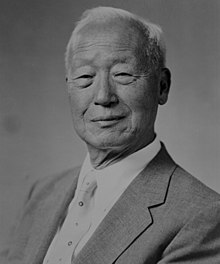

President of South Korea
Rhee Syngman 26 March 1875 Neungnae-dong, Daegyeong-ri, Masan-myeon, Pyeongsan County, Hwanghae, Joseon
19 July 1965(1965-07-19) (90) Honolulu, Hawaii, U.S.
24 July 1948 – 26 April 1960
First President of South Korea, from 1948 to 1960 This article is about former president of South Korea. For the Presbyterian minister, see Syngman Rhee (clergy). The native form of this personal name is Rhee Syngman. This article uses Western name order when mentioning individuals. In this Korean name, the family name is Rhee. His Excellency Syngman Rhee이승만 李承晩 Official Portrait1st President of South KoreaIn office 24 July 1948 – 26 April 1960Prime Minister Lee Beom-seok Shin Sung-mo Chang Myon Yi Yun-yong Chang Taek-sang Baek Du-jin Byeon Yeong-taeVice President Yi Si-yeong Kim Seong-su Ham Tae-young Chang MyonPreceded by Office establishedSucceeded by Yun PosunSpeaker of the National AssemblyIn office 31 May 1948 – 24 July 1948Preceded by Office establishedSucceeded by Shin Ik-heeChairman of the State Council of the Provisional Government of the Republic of KoreaIn office 3 March 1947 – 15 August 1948DeputyKim GuPreceded by Kim GuSucceeded by Office abolishedPresident of the Provisional Government of the Republic of KoreaIn office 11 September 1919 – 23 March 1925Prime Minister Yi Donghwi Yi Dongnyeong Sin Gyu-sik No Baek-rin Park EunsikPreceded by Office establishedSucceeded by Park Eunsik Personal detailsBornRhee Syngman (1875-03-26 ) 26 March 1875 Neungnae-dong, Daegyeong-ri, Masan-myeon, Pyeongsan County, Hwanghae, Joseon (now North Hwanghae, North Korea)Died19 July 1965(1965-07-19) (aged 90) Honolulu, Hawaii, U.S.Resting placeSeoul National Cemetery, Seoul, South KoreaNationalityKorean (1875–1910) Stateless (1910–1945) South Korean (1945–1965)Political partyLiberalSpouse(s)Francesca Donner Rhee (m. 1934–1965)Alma materGeorge Washington University (B.A.) Harvard University (M.A.) Princeton University (PhD)ReligionChristianitySignatureKorean nameHangul이승만/리승만 Hanja李承晩 Revised RomanizationI Seung(-)man / Ri Seung(-)manMcCune–ReischauerYi Sŭngman / Ri Sŭngman Syngman Rhee (Korean: 이승만 , pronounced ; 26 March 1875 – 19 July 1965) was a South Korean politician who served as the first President of South Korea from 1948 to 1960. Rhee was also the first and last president of the Provisional Government of the Republic of Korea from 1919 to his impeachment in 1925 and from 1947 to 1948. As President of South Korea, Rhee's government was characterised by authoritarianism, limited economic development, and in the late 1950s growing political instability and public opposition. Authoritarianism continued in South Korea after Rhee's resignation until 1988, except a few short breaks. Born in Hwanghae Province, Joseon, Rhee attended an American Methodist school, where he converted to Christianity. He became involved in anti-Japanese activities after the 1894–95 First Sino-Japanese War and was imprisoned in 1899. Released in 1904, he moved to the United States, where he obtained degrees from American universities and met President Theodore Roosevelt. After a brief 1910–12 return to Korea, he moved to Hawaii in 1913. From 1918 to 1924, he was promoted to several high positions in some Korean provisional governments and served as a representative of these to Western powers. He moved to Washington, D.C., in 1939. In 1945, he was returned to US-controlled Korea by the US military, and on 20 July 1948 he was elected President of the Republic of Korea with 92.7% of the vote, beating Kim Gu. Rhee adopted a hardline anti-communist and pro-American stance as president. Early on in his presidency, his government put down a communist uprising on Jeju Island, and the Mungyeong and Bodo League massacres were committed against suspected communist sympathisers, leaving at least 100,000 people dead. Rhee was president during the outbreak of the Korean War (1950–1953), in which North Korea invaded South Korea. He refused to sign the armistice agreement that ended the war, wishing to have the peninsula reunited by force. After the fighting ended, the country remained at a low level economically, lagging behind North Korea, and was heavily reliant on U.S. aid. After being re-elected in 1956, the constitution was modified to remove the two-term restriction, despite protests from the opposition. He was elected uncontested in March 1960, after his opponent Cho Byeong-ok died before voting day. After Rhee's ally Lee Ki-poong won the corresponding vice-presidential election by a wide margin, the opposition rejected the result as rigged, which triggered protests. These escalated into the student-led April Revolution when police shot demonstrators in Masan, which forced Rhee to resign on 26 April and ultimately led to the establishment of the Second Republic of Korea. On 28 April, as protesters converged on the presidential palace, the CIA covertly flew him out to Honolulu, Hawaii, where he spent the rest of his life in exile. He died of a stroke in 1965.

We use cookies
We use cookies and other tracking technologies to improve your browsing experience on our website, to show you personalized content and targeted ads, to analyze our website traffic, and to understand where our visitors are coming from. Privacy Policy.